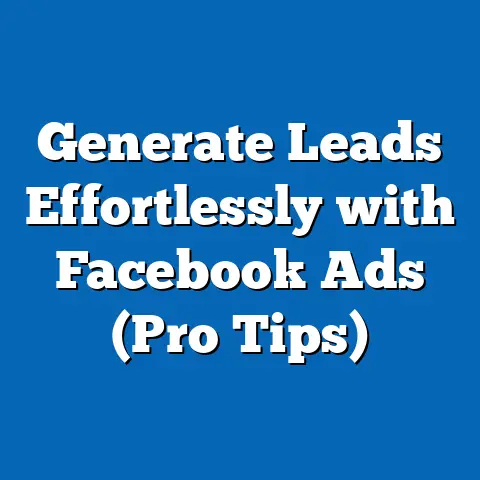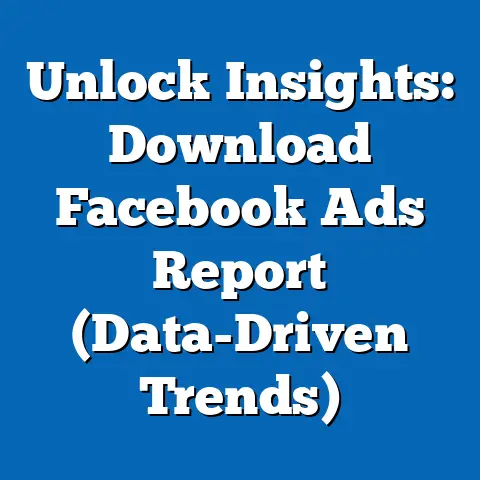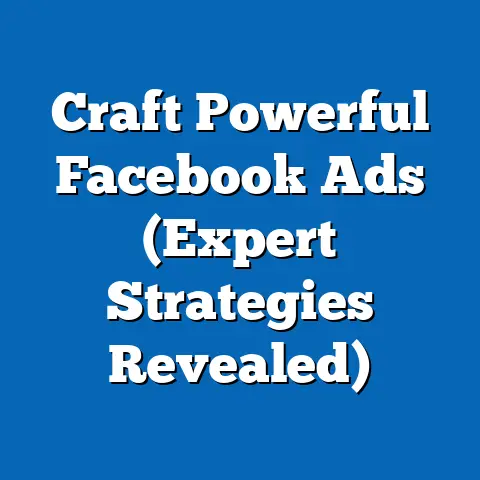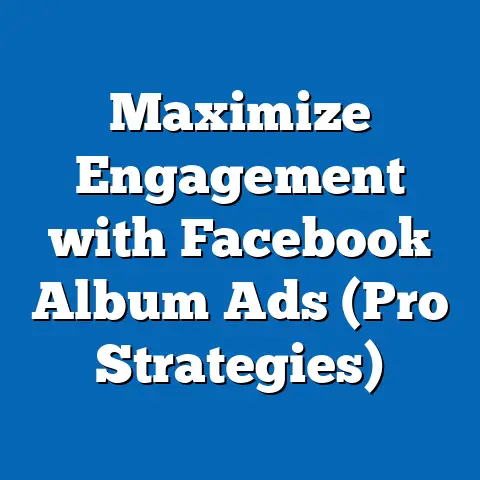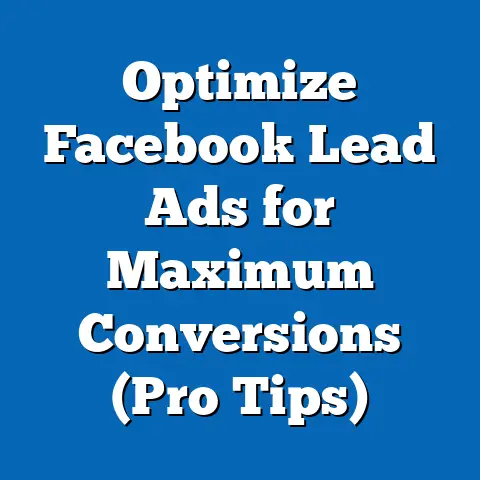Boost Facebook Ads with Impactful Text (Proven Strategies)
Have you ever poured time and money into a Facebook ad campaign only to see lackluster results, with low engagement and minimal conversions? In the fast-paced world of digital marketing, crafting impactful ad text is no longer just an option—it’s a necessity. As one of the most powerful advertising platforms with over 2.9 billion monthly active users as of 2023, Facebook offers unparalleled reach, but standing out in a crowded newsfeed requires precision, creativity, and strategy.
Facebook ads are defined by their ability to target hyper-specific demographics, leveraging user data to deliver personalized content. However, the text accompanying these ads—whether it’s a headline, body copy, or call-to-action (CTA)—plays a pivotal role in capturing attention and driving action. Since the platform’s inception in 2004 and the introduction of ads in 2007, Facebook advertising has evolved from simple sidebar promotions to sophisticated, algorithm-driven campaigns integrated with visuals and interactive elements.
Historically, the rise of social media advertising mirrors broader societal shifts toward digital communication and e-commerce, with businesses increasingly relying on platforms like Facebook to connect with consumers during key cultural moments—think holiday shopping seasons or global events like the 2020 pandemic, which saw a 60% surge in online ad spending. The societal implications are vast: effective ad text can shape consumer behavior, influence cultural trends, and even impact political discourse, as seen in high-profile cases like the 2016 U.S. election. This article dives deep into proven strategies for crafting impactful Facebook ad text, exploring psychological triggers, data-driven tactics, and real-world applications to help marketers maximize their return on investment (ROI).
Section 1: Understanding the Power of Text in Facebook Ads
In the realm of digital advertising, visuals often take center stage, but text remains the backbone of any successful Facebook ad. A striking image or video may grab attention, but it’s the ad copy that convinces users to click, engage, or purchase. According to a 2022 study by Hootsuite, ads with clear, concise, and emotionally resonant text achieve up to 30% higher click-through rates (CTR) compared to those with generic messaging.
Facebook’s algorithm prioritizes content that sparks interaction—likes, comments, and shares—which means ad text must be crafted to elicit a response. This is where understanding user psychology comes into play. Text that taps into emotions like curiosity, urgency, or desire can transform a passive scroller into an active participant.
Moreover, the constraints of Facebook’s ad formats—such as character limits for headlines (40 characters) and primary text (125 characters visible before truncation)—demand brevity and impact. Marketers must distill their message into a few powerful words while aligning with the brand voice and campaign goals. The challenge lies in balancing creativity with clarity, a skill that has become increasingly vital as ad fatigue grows among users bombarded with content daily.
Section 2: Historical Context of Facebook Advertising and Text Evolution
When Facebook first introduced ads in 2007, they were rudimentary, often resembling classified listings with minimal text and basic images. These early ads targeted users based on profile data like age and location, but the text was rarely optimized for engagement, focusing instead on straightforward product descriptions. As the platform grew, so did the sophistication of its advertising tools, with the launch of the News Feed ads in 2012 marking a turning point—suddenly, ads were integrated into users’ organic content, demanding more compelling copy to avoid being ignored.
The 2010s saw a cultural shift toward mobile-first browsing, with over 98% of Facebook users accessing the platform via mobile devices by 2020. This necessitated shorter, punchier ad text to fit smaller screens and shorter attention spans. Simultaneously, events like the Cambridge Analytica scandal in 2018 raised concerns about data privacy, pushing Facebook to refine its targeting options and placing greater emphasis on ad relevance—text had to resonate deeply to justify the use of personal data.
Today, impactful ad text reflects broader societal trends, such as the demand for authenticity and social responsibility. Ads promoting sustainability or inclusivity, for instance, often outperform purely transactional messaging, as consumers—especially younger generations like Millennials and Gen Z—prioritize brands with purpose. Understanding this historical and cultural backdrop is crucial for crafting text that aligns with current user expectations.
Section 3: Key Characteristics of Impactful Facebook Ad Text
What separates a forgettable ad from one that drives results? Several defining characteristics emerge from both qualitative research and quantitative data. Let’s break them down:
-
Clarity and Conciseness: With limited space and even less time to capture attention, impactful ad text gets to the point quickly. A headline like “Save 50% Today!” outperforms vague alternatives like “Check Out Our Deals” because it communicates value instantly.
-
Emotional Appeal: Text that evokes emotion—whether it’s excitement, fear of missing out (FOMO), or empathy—creates a connection. For instance, charity ads often use phrases like “Help a Child Today” to tug at heartstrings, while e-commerce ads might use “Don’t Miss Out!” to spark urgency.
-
Personalization: Addressing the user directly with “you” or tailoring text to their interests (e.g., “Gamers, Level Up with This Gear!”) increases relevance. Facebook’s dynamic ad features allow text to adapt based on user behavior, amplifying this effect.
-
Strong Call-to-Action (CTA): A clear directive—such as “Shop Now,” “Learn More,” or “Sign Up Free”—guides users on the next step. Studies show that ads with actionable CTAs can boost CTR by up to 20%.
-
Value Proposition: Highlighting benefits over features is key. Instead of saying “Our Shoes Are Durable,” effective text might read, “Walk Comfortably All Day with Our Shoes!”—focusing on the user’s gain.
These characteristics aren’t one-size-fits-all; their application varies based on audience demographics, industry, and campaign objectives. However, they form the foundation of text that cuts through the digital noise.
Section 4: Proven Strategies for Crafting Impactful Facebook Ad Text
Now that we’ve established the core traits of effective ad text, let’s explore actionable strategies backed by research and real-world success. These approaches blend creativity with data-driven insights to optimize performance.
4.1 Leverage the Power of Storytelling
Humans are wired for stories, and even in the constrained format of a Facebook ad, narrative elements can make a big impact. A short, relatable anecdote or problem-solution framework can draw users in. For example, a fitness brand might start with “Tired of workouts that don’t work?” before offering their program as the solution.
Storytelling doesn’t have to be lengthy—sometimes a single line implying a journey, like “From zero to hero with our app!” can evoke curiosity. A 2021 study by Sprout Social found that ads with narrative elements saw 25% higher engagement rates than purely promotional content.
4.2 Use Power Words and Emotional Triggers
Certain words carry inherent emotional weight and can spur action. Terms like “free,” “exclusive,” “limited,” “instant,” and “new” tap into desires for value, uniqueness, and urgency. For instance, “Get Your Free Trial Now!” combines a benefit (free) with immediacy (now).
Emotional triggers vary by audience—parents might respond to “safe” or “protect,” while younger users might react to “epic” or “viral.” Testing different power words through A/B testing is essential, as cultural and regional differences can influence their effectiveness.
4.3 Create a Sense of Urgency and Scarcity
FOMO is a powerful motivator, and ad text that implies limited availability or time-sensitive offers can drive immediate action. Phrases like “Only 24 Hours Left!” or “Limited Stock—Act Fast!” push users to click before the opportunity slips away. A 2020 report by eMarketer noted that urgency-driven ads increased conversion rates by 15% on average.
However, authenticity matters—overusing urgency tactics or creating false scarcity can erode trust. Pair these messages with genuine offers to maintain credibility.
4.4 Ask Questions to Spark Engagement
Rhetorical or direct questions in ad text can stop users mid-scroll by prompting self-reflection or curiosity. A beauty brand might ask, “Ready for Flawless Skin?” while a career service could use, “Looking for Your Dream Job?” Such questions invite mental participation, increasing the likelihood of interaction.
Questions also work well for comment-driven campaigns, where the goal is to boost engagement metrics. For example, “What’s Your Favorite Summer Destination?” paired with a travel ad can generate responses, signaling relevance to Facebook’s algorithm.
4.5 Highlight Social Proof
Consumers trust peers more than brands, and ad text that incorporates social proof—testimonials, reviews, or statistics—builds credibility. Text like “Join 10,000+ Happy Customers!” or “Rated 5 Stars by Users!” reassures potential buyers of a product’s value. According to Nielsen, 92% of consumers trust peer recommendations over traditional advertising, making this strategy particularly potent.
User-generated content (UGC) can enhance this effect—quoting a real customer’s feedback in the ad text adds authenticity. Just ensure the claims are verifiable to avoid misleading users.
4.6 Optimize for Mobile and Brevity
With the majority of Facebook users on mobile devices, ad text must be concise and scannable. Front-load the most important information in the first 2-3 words of the headline and primary text, as truncation cuts off longer copy. For example, “50% Off Starts Now!” is more effective than “We’re Offering a 50% Discount Today!” because the discount is visible immediately.
Mobile optimization also means avoiding complex language or jargon—keep it simple and direct. Tools like Facebook’s Text Overlay Tool can help ensure text doesn’t overcrowd visuals, maintaining a clean, thumb-friendly design.
4.7 Test and Iterate with A/B Testing
No single piece of ad text works universally, which is why continuous testing is critical. A/B testing—running two versions of an ad with different text (e.g., varying headlines or CTAs)—reveals what resonates with your audience. A 2022 study by HubSpot found that marketers who regularly test ad copy see up to 40% improvement in campaign performance over time.
Focus on testing one variable at a time (headline, body text, or CTA) to isolate what drives results. Use Facebook’s Ads Manager to track metrics like CTR, conversion rate, and cost-per-click (CPC), refining your approach based on data.
Section 5: Societal and Cultural Factors Influencing Ad Text Effectiveness
The effectiveness of Facebook ad text isn’t just about word choice—it’s deeply tied to societal and cultural dynamics. For instance, economic conditions shape how users respond to offers. During recessions or periods of financial uncertainty, like the 2008 financial crisis or post-COVID recovery, text emphasizing affordability and value (“Save Big!” or “Budget-Friendly Solutions”) tends to perform better.
Cultural trends also play a role—ads reflecting current movements, such as sustainability or diversity, resonate with socially conscious audiences. A 2023 survey by Statista found that 65% of Gen Z users prefer brands that align with their values, prompting text like “Eco-Friendly Products for a Better Tomorrow.” Meanwhile, regional differences matter—humor or slang that works in the U.S. might fall flat or offend in other markets, necessitating localized copy.
Technological advancements, like the rise of AI-driven personalization, further influence ad text strategies. Dynamic ads that automatically adjust text based on user search history or interests are becoming standard, but they raise ethical questions about privacy and manipulation. Marketers must balance innovation with transparency to maintain consumer trust.
Section 6: Implications for Businesses, Marketers, and Society
The art of crafting impactful Facebook ad text has far-reaching implications beyond individual campaigns. For businesses, mastering this skill can mean the difference between thriving and stagnating in a competitive digital landscape. High-performing ads reduce customer acquisition costs, improve brand visibility, and drive revenue—critical factors for small businesses with limited budgets, which make up 90% of advertisers on Facebook, per a 2021 platform report.
For marketers, the focus on ad text sharpens communication skills and data literacy, as success hinges on interpreting analytics and adapting to trends. It also underscores the importance of ethical advertising—misleading text or overpromising can damage brand reputation and invite regulatory scrutiny, as seen with stricter ad policies post-2018 data scandals.
Societally, the power of ad text shapes consumer culture, influencing what people buy, value, and discuss. It can amplify positive messages, like public health campaigns during pandemics (“Get Vaccinated Today!”), but also risks perpetuating materialism or misinformation if not handled responsibly. As digital natives like Gen Z become primary consumers, their demand for authenticity will likely push ad text toward greater transparency and purpose-driven messaging.
In the workplace, the emphasis on digital advertising reshapes job roles, with demand for copywriters, data analysts, and social media strategists soaring. Companies must invest in training to keep pace with evolving best practices, ensuring teams can craft text that aligns with both business goals and user expectations.
Section 7: Real-World Case Studies of Impactful Facebook Ad Text
To ground these strategies in reality, let’s examine a few success stories where ad text made a measurable difference.
-
Dollar Shave Club: Known for disruptive marketing, Dollar Shave Club ran a Facebook ad with the headline “Shave Time. Shave Money.” This clever wordplay combined humor with a clear value proposition, resulting in a 35% higher CTR compared to their previous campaigns, per a 2019 case study by AdEspresso. The text’s brevity and wit cut through clutter, proving the power of creative language.
-
Airbnb: During the 2020 pandemic, Airbnb pivoted to promote local getaways with text like “Escape Close to Home.” This tapped into users’ desire for safe travel while addressing economic and health concerns, leading to a 20% increase in bookings for nearby destinations, according to internal data shared in a 2021 report. The emotionally resonant text aligned perfectly with the cultural moment.
-
Charity: Water: This nonprofit used social proof and emotional appeal with text reading, “$30 Gives Clean Water to One Person. Join Us!” The specificity of the impact ($30 for one person) and direct CTA (“Join Us”) drove a 40% uptick in donations during their 2022 campaign, as reported by Social Media Examiner. This highlights how clarity and empathy can work hand-in-hand.
These cases illustrate that impactful text isn’t about gimmicks—it’s about understanding the audience’s mindset and delivering a message that resonates at the right time.
Section 8: Challenges and Nuances in Crafting Ad Text
Despite the proven strategies, crafting effective Facebook ad text isn’t without challenges. Audience diversity means a one-size-fits-all approach rarely works—text that appeals to Baby Boomers might alienate Gen Z, and vice versa. For example, older users may prefer formal, benefit-focused language, while younger users gravitate toward casual, trend-driven phrases.
Ad fatigue is another hurdle; users exposed to repetitive messaging may ignore even well-written text. Rotating copy and visuals regularly can mitigate this, but it requires ongoing creativity and resources. Additionally, Facebook’s strict ad policies—banning exaggerated claims or sensitive content—can limit expression, forcing marketers to find subtle ways to convey urgency or emotion.
There’s also the risk of over-optimization. Relying too heavily on data or trends can strip text of authenticity, making it feel formulaic. Balancing analytics with genuine storytelling is key to maintaining a human touch. Finally, cultural missteps—such as tone-deaf humor or inappropriate references—can backfire, as seen in several high-profile ad flops. Thorough audience research and sensitivity training are essential to avoid such pitfalls.
Section 9: Forward-Looking Insights and Future Trends
As we look to the future, several trends are poised to shape the landscape of Facebook ad text. The rise of AI and machine learning will likely automate much of the copywriting process, with tools generating personalized text at scale. However, human oversight will remain crucial to ensure emotional depth and ethical boundaries are respected.
The shift toward video content on platforms like Reels suggests ad text may play a supporting role, integrated as captions or overlays. Yet, its importance won’t diminish—short, punchy phrases will still be needed to hook viewers in the first few seconds. Additionally, as privacy regulations tighten (e.g., Apple’s App Tracking Transparency framework), targeting precision may decrease, placing greater pressure on text to appeal broadly while remaining relevant.
Societally, the push for authenticity and inclusivity will intensify, with users expecting ad text to reflect real-world diversity and values. Brands that fail to adapt risk losing relevance, especially among younger demographics. On the flip side, those who master impactful, purpose-driven text will build lasting loyalty in an increasingly discerning market.
Uncertainty remains around how emerging technologies like the metaverse or blockchain-based advertising will influence platforms like Facebook (now Meta). Will ad text become immersive, tied to virtual experiences? Only time will tell, but adaptability will be the hallmark of successful marketers.
Conclusion: The Art and Science of Impactful Facebook Ad Text
Crafting impactful text for Facebook ads is both an art and a science, blending creativity with data-driven precision to capture attention in a split second. From leveraging emotional triggers and urgency to embracing storytelling and social proof, the strategies outlined in this article offer a roadmap for success, grounded in historical context, cultural awareness, and real-world results. Yet, the diversity of audiences and the rapid evolution of technology remind us that there’s no static formula—continuous testing, learning, and adaptation are non-negotiable.

